AMD just dropped their latest 7000 series of GPUs based on their new RDNA 3 architecture. Today, we will be comparing two of the best GPUs from this lineup, the RX 7900 XTX vs RX 7900 XT, and see how much better is the latter one.
Previously, we compared RX 7900 XTX vs RX 6900 XT to see how much performance gain we are looking at.
Key Takeaways
- Radeon RX 7900 XTX and RX 7900 XT are two high-end GPUs from AMD’s latest 7000 series GPUs based on the RDNA3 architecture.
- RX 7900 XTX is roughly 3 to 23% better in games than RX 7900 XT.
- RX 7900 XT is more power efficient as it has a smaller TDP and PSU requirement.
- 7900 XTX has more VRAM at around 24 GB compared to the 20 GB of 7900 XT.
- RX 7900 XTX is approximately 10% cheaper than RX 7900 XT at launch price.
Comparison Table
| Specs | Radeon RX 7900 XTX | Radeon RX 7900 XT |
| Architecture | RDNA 3 | RDNA 3 |
| GPU Name | Navi 31 XTX | Navi 31 XT |
| Foundry | TSMC 5nm | TSMC 5nm |
| Base Clock Speed | 1855 MHz | 1500 MHz |
| Boost Clock Speed | 2499 MHz | 2394 MHz |
| Memory Capacity | 24 GB GDDR6 | 20 GB GDDR6 |
| Memory Interface Speed | 2500 MHz | 2500 MHz |
| Bus Interface | PCIe 4.0 x16 | PCIe 4.0 x16 |
| Thermal Design Power (TDP) | 355 Watts | 300 Watts |
| No. of transistors | 57,700 million | 57,700 million |
| RT Cores | 96 | 84 |
| TMUs | 384 | 336 |
| Price | 999 USD | 899 USD |
| Release Date | Nov 3rd, 2022 | Nov 3rd, 2022 |
| Best Variants | Best RX 7900 XTX Cards |
Similarities In Specifications
Radeon RX 7900 XT and RX 7900 XTX are two very similar GPUs. Before we head over to discuss the difference between them, let us look at what is common between these GPUs. 7900 XT and 7900 XTX come from AMD’s latest 7000 series of GPUs, sharing the same RDNA 3 architecture.
They are based on TSMC’s 5 nm processing node and share the same Navi 31 product name. Both are based on the same MCM package AMD designed on the 6 nm process size. This chiplet design has allowed AMD to significantly cut back the costs of these GPUs, allowing them to present it to a broader audience while competing with the high-end GPUs from Nvidia’s side.
Both of these GPUs have 57,700 million transistors on them while also sharing the same 520mm² die size. The bus interface is also the same across both these GPUs, i.e., PCIe 4.0 x16. They both share a similar port layout consisting of 1X HDMI 2.1a, 2x DisplayPort 2.1, and 1x USB Type C. Lastly, these GPUs have the same 2x 8-pin power converters for power. Before proceeding further, why not check our RX 7900 XT vs RTX 4080 comparison?
Differences In Specifications
On paper, it is obvious that AMD’s greatest, 7900 XTX is ahead of their second-best GPU at the moment, i.e., RX 7900 XT, in more than a few ways. For starters, it is able to clock 21% faster than 7900 XT in base clock speeds, maintaining an average of 1855 MHz, whereas 7900 XT maxes out at 1500 MHz. Both these GPUs run at a much higher frequency when we move over to the boost clock. However, 7900 XTX is still able to clock 4.2% faster. It can consistently run at 2499 MHz when overclocked. Contrary to that, the 7900 XT maxes out at 2394 MHz.
7900 XTX also gets an edge in memory capacity as it gets approximately 18% more memory. It boasts a total of 24 GB VRAM. 7900 XT, on the other hand, gets a good 20 GB VRAM. Both VRAMS are the same GDDR6 memory, running at 2500 MHz. This allows developers more creative freedom with their work while also future-proofing their rigs since games are getting increasingly demanding with every passing day.
Gamers also into content creation will be more inclined towards the 7900 XTX as it boasts significantly better render configuration specs than the 7900 XT. For starters, it offers 13.3% more shading units, giving a total of 6144 units compared to 5376 on 7900 XT. 7900 XTX is also exactly 13.3% ahead in terms of texture mapping units, boasting a total of 384 TMUs. 7900 XT, on the other hand, could only offer 336 units. Lastly, we notice that 7900 XTX also has more ray tracing cores, offering 96 rt cores, compared to 84 on 7900 XT.
Lastly, all these perks and additional benefits of 7900 XTX come at two costs, price and power consumption. Starting with power consumption, the 7900 XTX has a 16.7% higher TDP than the 7900 XT at around 355 watts. Whereas 7900 XT’s TDP is capped at 300 watts by AMD.
You will also need a bigger PSU of at least 750 watts to handle this beast, whereas 7900 XT can get by on a 700 watts PSU too. Lastly, perhaps the most obvious difference between both GPUs is price. 7900 XTX costs 10% more than 7900 XT at launch price. It starts at 999 USD, whereas 7900 XT starts at 900 USD. Let us head over to the gaming benchmarks and see if the 7900 XTX is able to justify that price tag.
RX 7900 XTX Vs RX 7900 XT: Gaming Benchmarks
From what we have seen, it is pretty evident that the 7900 XTX is ahead of the 7900 XT in several aspects. However, it is one thing to be good on paper and another to be good in real-life tasks such as gaming.
For this purpose, we will let these GPUs lock horns against each other in some of the latest recent games in two different resolutions. This will give us a better understanding of how these GPUs perform against each other in the task we buy them for, i.e., gaming.
We will head to TheSpyHood’s YouTube channel for the RX 7900 XTX vs RX 7900 XT gaming benchmarks. All the titles were tested on maxed-out settings in two different resolutions, i.e., 2160p and 1440p, on the following rig with both CPUs running on stock configuration.
Testing Rig
- CPU: Intel Core i9-13900K
- Motherboard: Asus ROG Strix Z790-E Gaming WIFI
- CPU Cooler: MSI MAG Core Liquid C360 AIO cooler
- GPU 1: AMD Radeon RX 7900 XTX 24 GB
- GPU 2: AMD Radeon RX 7900 XT 20 GB
- RAM: 64 GB DDR5 6000 MHz (4*16 GB)
- PSU: 1200 watts Asus ROG Thor Platinum II
Cyberpunk 2077
Cyberpunk 2077 is one of the heaviest and most demanding games. It is both a CPU and GPU-intensive title.
1440p
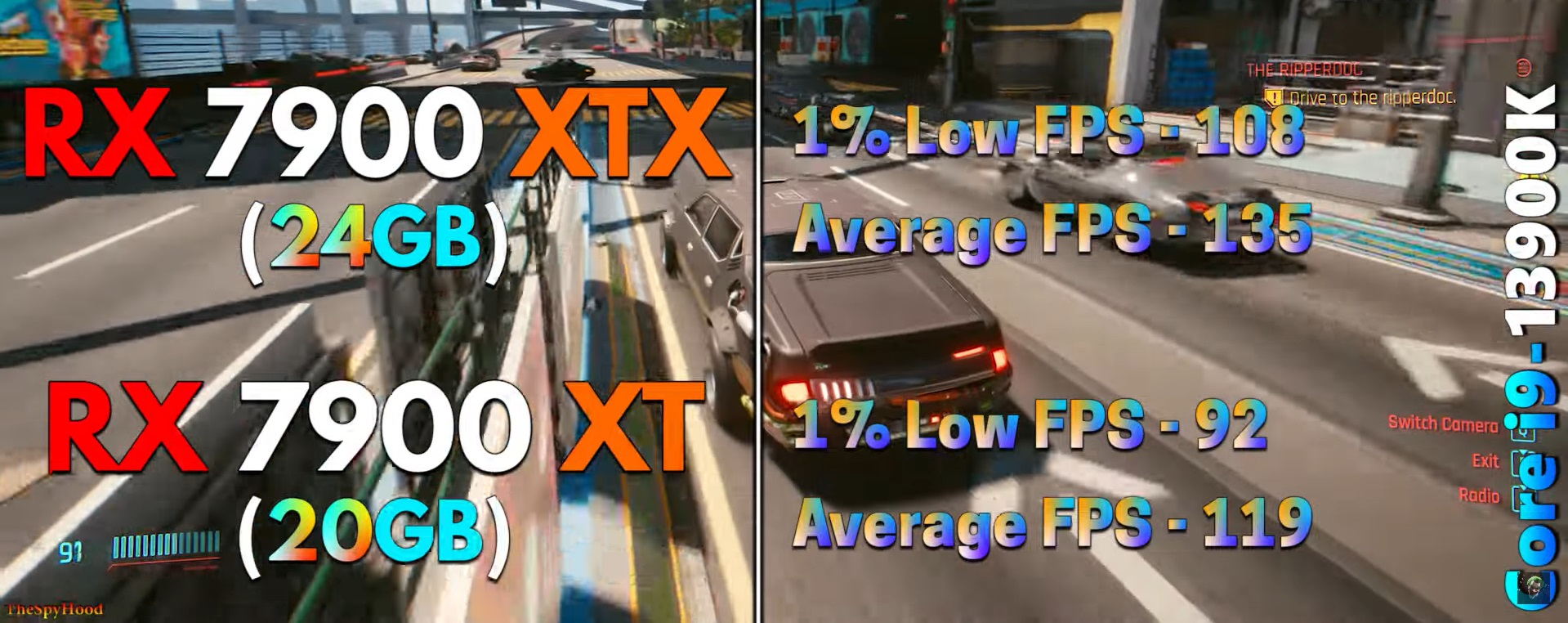
- Right off the bat, we can see that 7900 XTX leads our first benchmark by a margin of 12.59% in average fps at 1440p resolution.
- It consistently offered an average of 135 fps, whereas the 7900 XT maxed out at 119 fps.
- Even the 1% lows of 7900 XTX were able to hit triple digits, averaging around 108 fps.
- 7900 XT was 16% behind, yielding an average of 92 1% low fps.
2160p
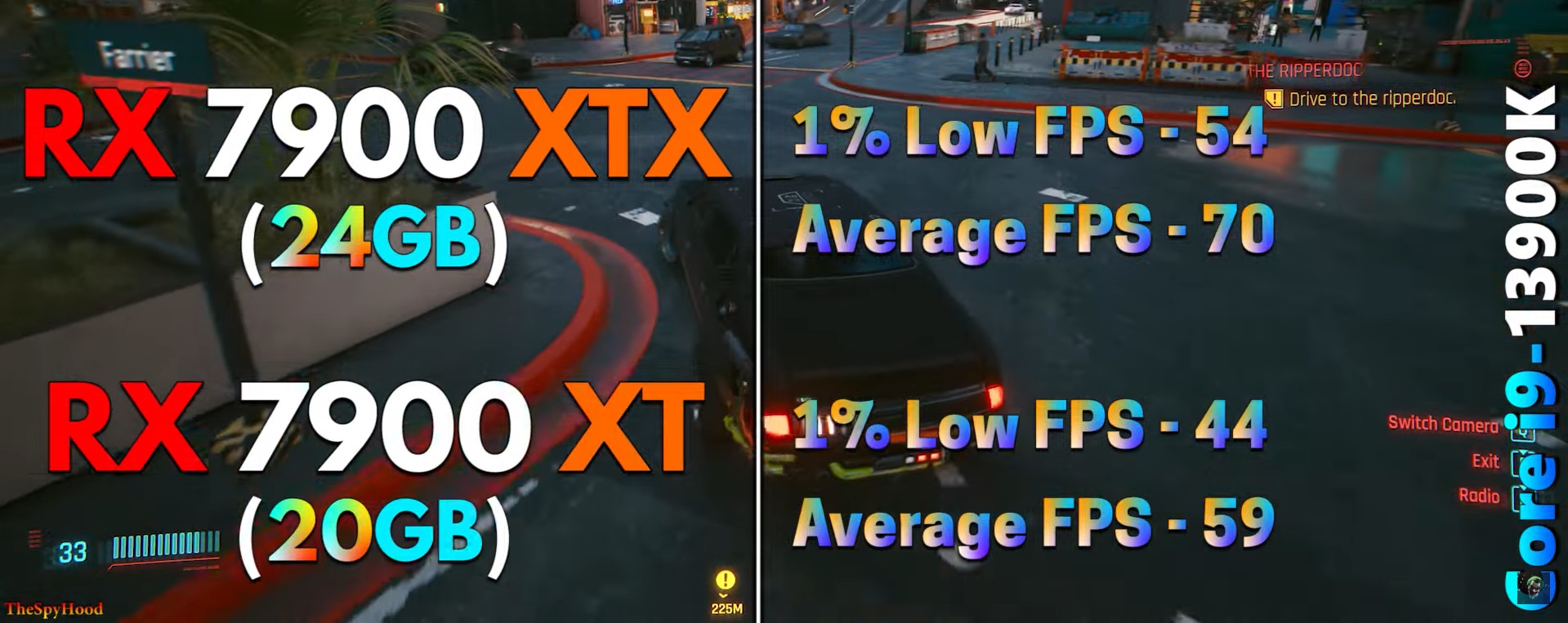
- As we move over to the higher resolution, we see the gap extending to 16% since we are more dependent on the GPU.
- This time around, it gave us an average of 70 fps, whereas 7900 XT was just a single frame shy of the sweet 4k60 fps experience, averaging around 59 fps.
- The difference in 1% lows was bigger this time, around 20% in favor of 7900 XTX.
- This time, the 1% lows of the 7900 XTX were hovering around 54 fps, and exactly 10 frames behind were the 7900 XT, averaging near 44 fps.
Horizon Zero Dawn
Horizon Zero Dawn is a little heavier on the GPU than the CPU. It scales really well as we continue to upscale our core count.
Also Read: RX 7900 XT vs RTX 3080 Ti
1440p
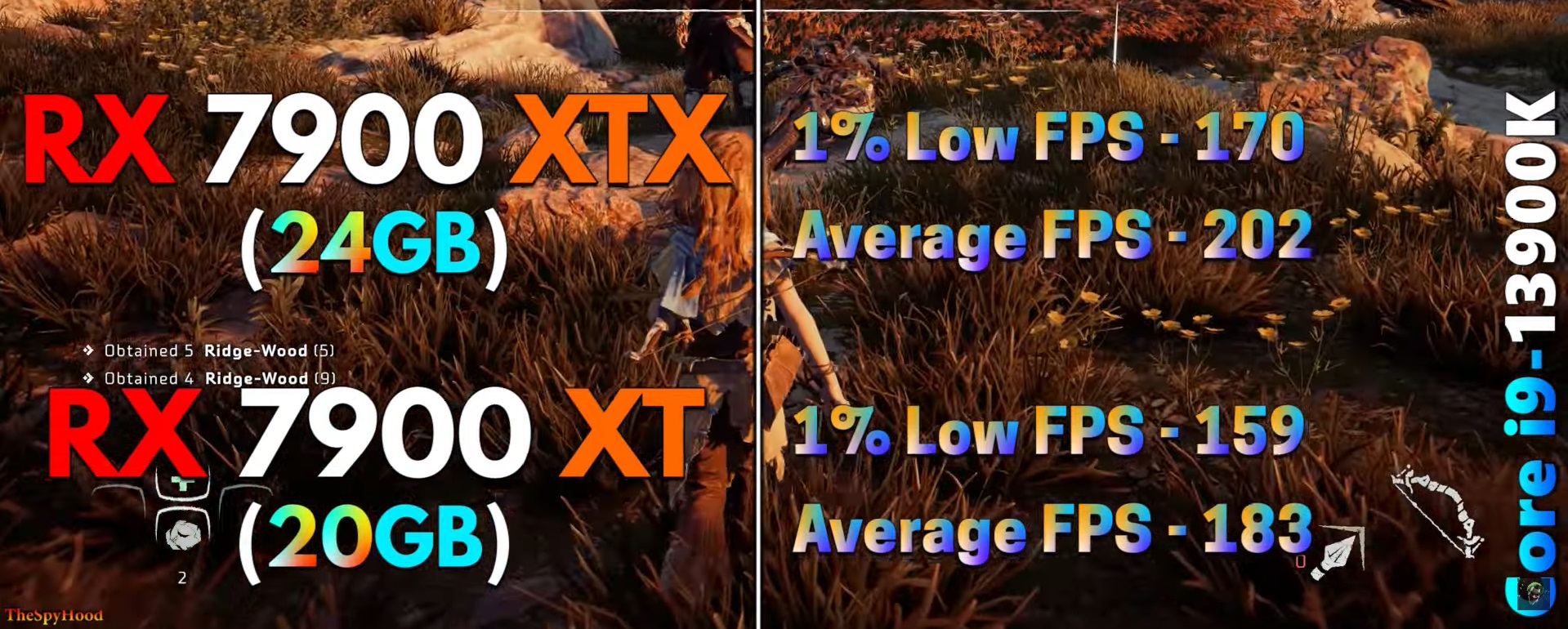
- Horizon Zero Dawn was a little lighter on our GPUs than the previous title, as both gave respectable framerates. However, 7900 XTX is still ahead with a margin of 9.8%.
- It even broke the 200 fps barrier, averaging around 202 fps. 7900 XT struggled to catch up as it capped at an average of 183 fps.
- 1% lows saw a smaller difference of 6%, with 7900 XTX coming on top.
- It was able to deliver 170 1% low fps. 7900 XT, at the same time, was 11 frames behind, giving us an average of 159 1% low fps.
2160p
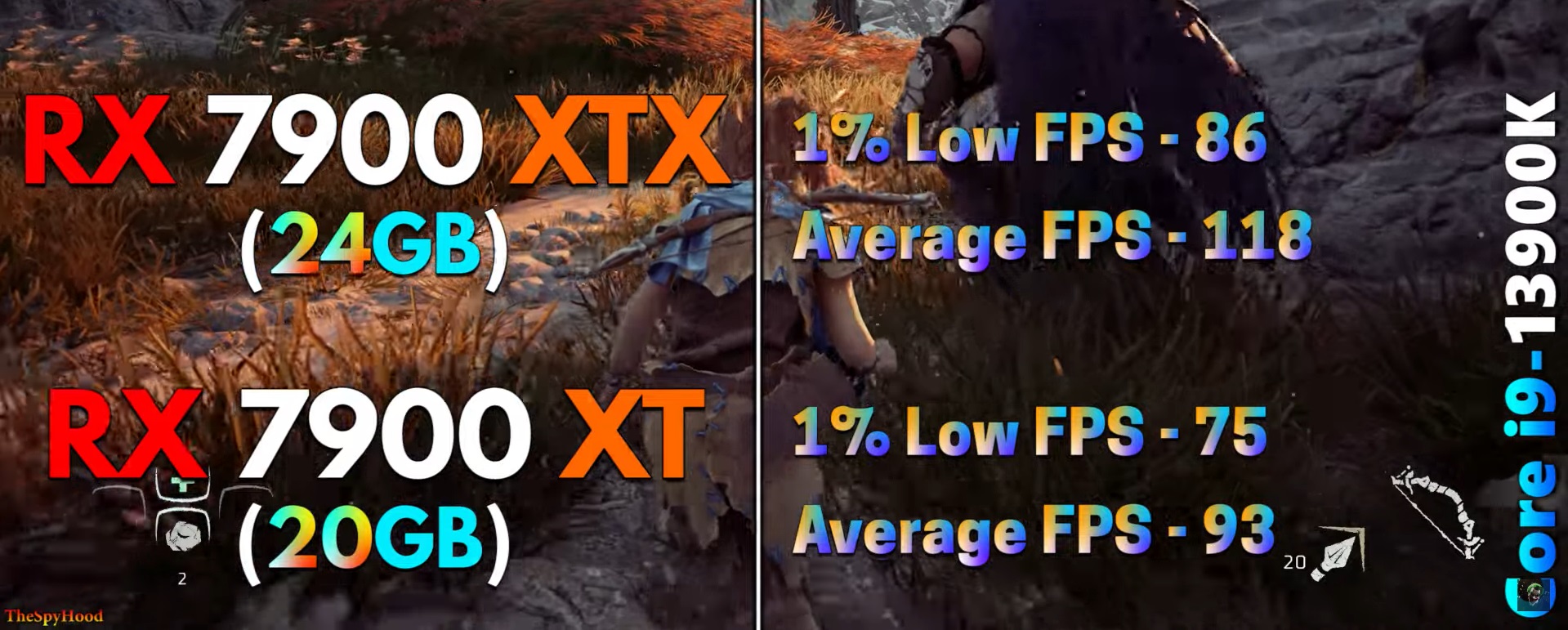
- The higher 2160p resolution was equally merciless on both GPUs, as we observed a significant drop in the fps of both GPUs. However, 7900 XTX retains its lead by a margin of 23.6%.
- 7900 XTX was shy of 2 fps from reaching the sweet 120 fps mark, averaging around 118 fps. 7900 XT, on the other hand, could only yield 93 fps on average.
- 1% lows saw a much smaller difference of around 13%, this time in favor of 7900 XTX.
- 7900 XTX was, once again, 11 frames ahead, yielding us a total of 86 1% lows compared to 75 on 7900 XT.
Watch Dogs Legion
Watch Dogs Legion is a perfect game to test our contenders, as it gets severely merciless on modern hardware due to its bad optimization.
1440p
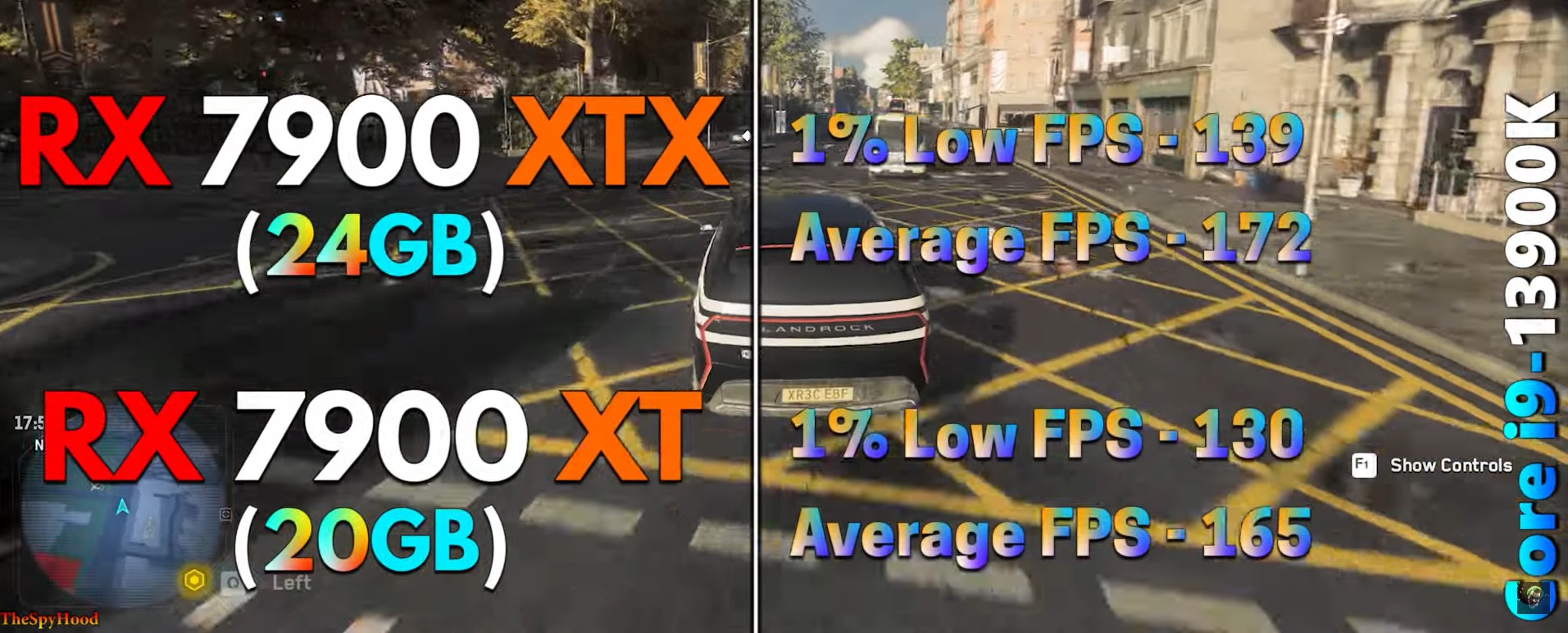
- Watch Dogs Legion saw one of the smallest differences observed throughout the benchmark, as 7900 XTX was only 4% ahead now in terms of average fps.
- 7900 XTX was able to deliver solid 172 fps on average. Exactly 7 frames behind was 7900 XT offering us a very respectable average of 165 fps.
- 1% lows saw a slightly bigger difference of around 6.69% in favor of 7900 XTX.
- It pushed out 139 frames when it came to 1% lows. 7900 XT, on the other hand, was 9 frames behind, pushing out a total of 130 fps in terms of 1% lows.
2160p
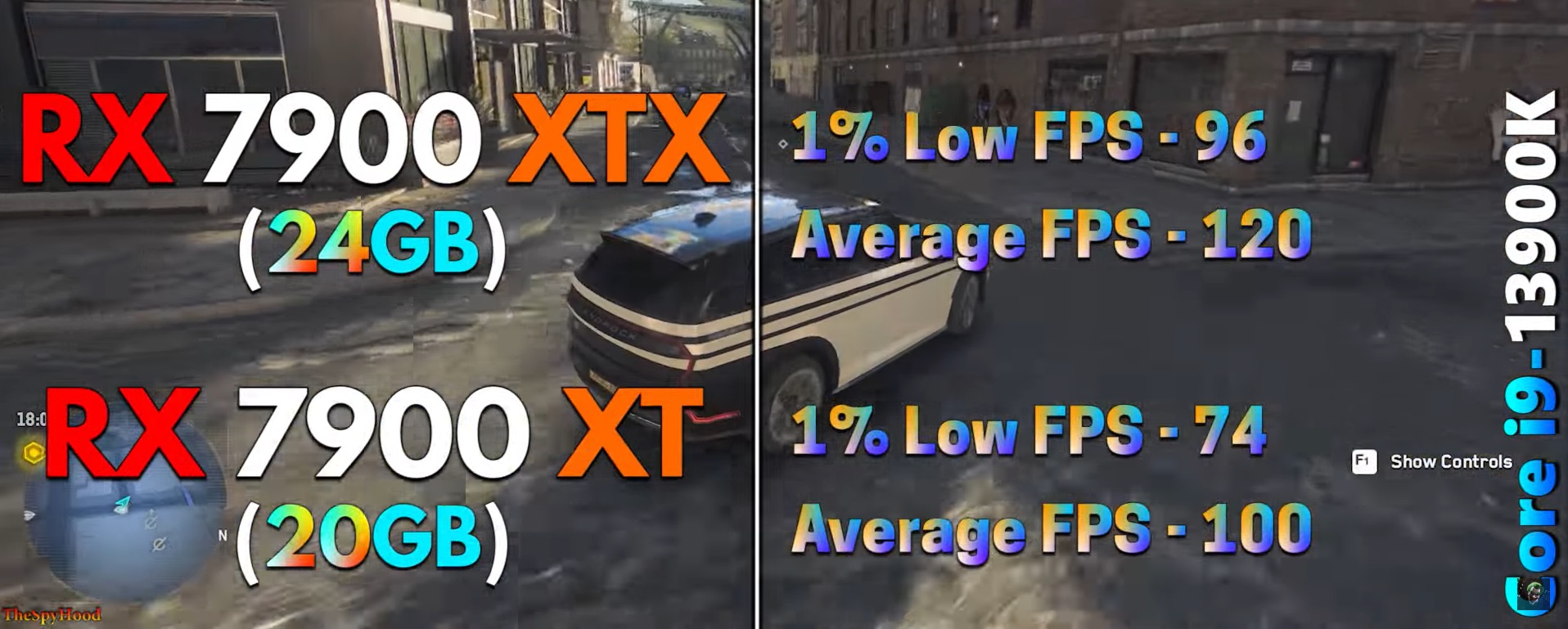
- At 2160p, the gap in average fps seems to have expanded to 18% in favor of 7900 XTX.
- It was now delivering a solid 120 fps experience. In comparison, the 7900 XT was just able to touch the triple digits, giving us an average of 100 fps.
- The game ran slightly smoother on 7900 XTX, 25% ahead in terms of 1% lows.
- It managed to provide a respectable 96 1% low fps on average. 7900 XT, on the other hand, could only provide a total of 74 fps.
Call Of Duty Warzone 2
Call of Duty Warzone 2 is an extremely demanding title that tends to rely more on the GPU side. However, you will still need a beefy CPU to load those maps and textures on the spot.
1440p
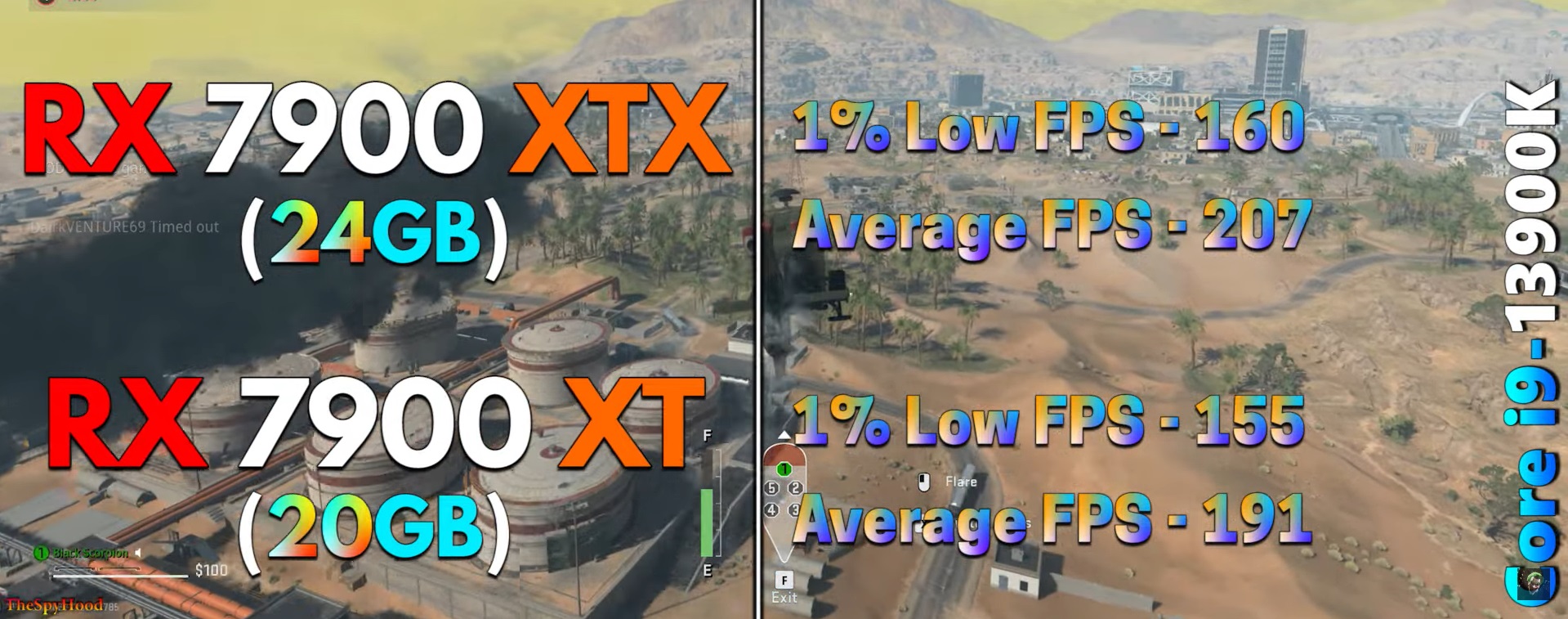
- Call of duty Warzone 2 ran extremely smoothly on 7900 XTX, as it was approximately 8% faster, crossing the 200 fps threshold and averaging around 207 fps.
- At the same time, 7900 XT was 9 frames shy of providing us with a 200 fps experience, giving us a total average of 191 fps.
- To 7900 XT’s credit, it managed to close the gap in 1% lows to a mere 3% only.
- It was able to deliver a solid 160 fps in terms of 1% lows. Contrary to that, the 7900 XT was 5 frames behind, giving us a total of 155 fps.
2160p
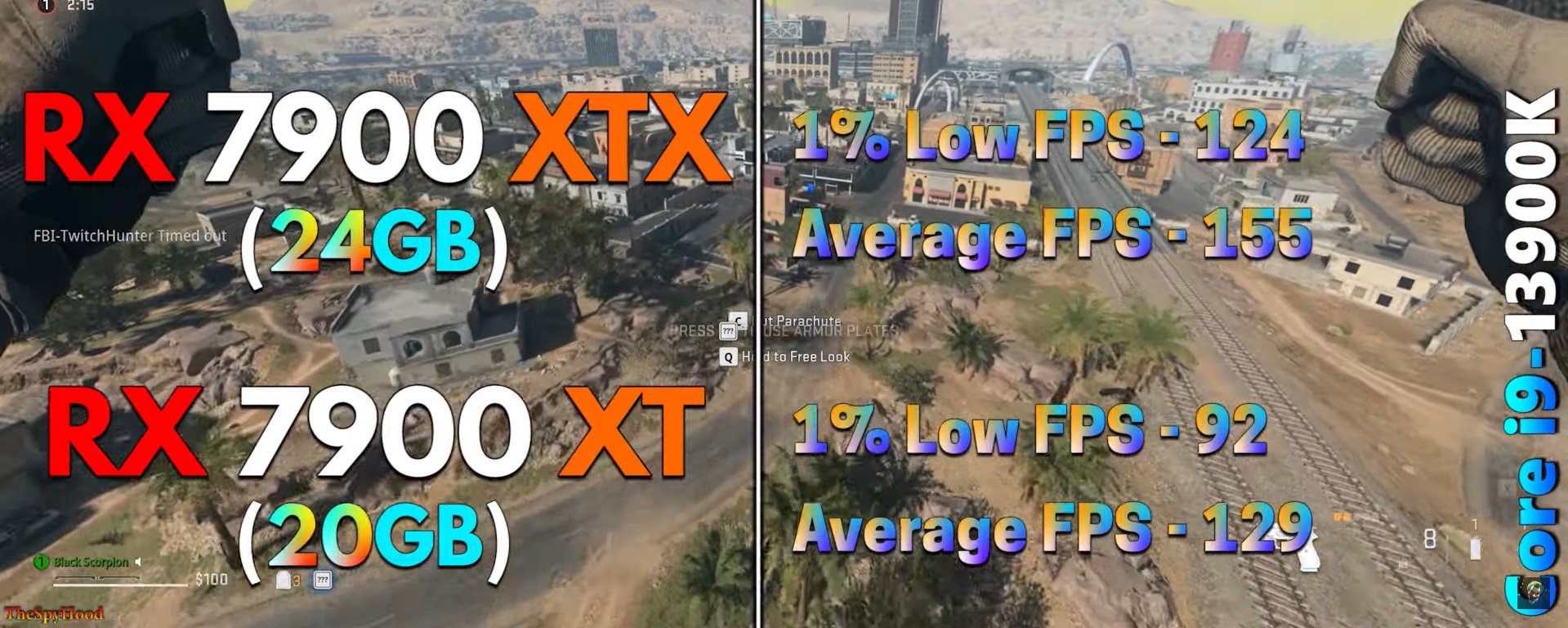
- The higher 2160p resolution was a little harsh on the 7900 XT now, as it was 18% behind the 7900 XTX.
- It managed to run the game at an average of 129 fps. Compared to that, 7900 XTX provided solid gains while averaging at 155 fps.
- The game also ran much smoother on 7900 XTX, as it was a whopping 30% ahead in terms of 1% lows.
- It managed to deliver an average of 124 1% low fps. 7900 XTX could not catch up, as it was only delivering 92 fps.
Hitman 3
Despite being better optimized than its predecessor, the latest title in the Hitman series can still give many GPUs a run for their money.
1440p
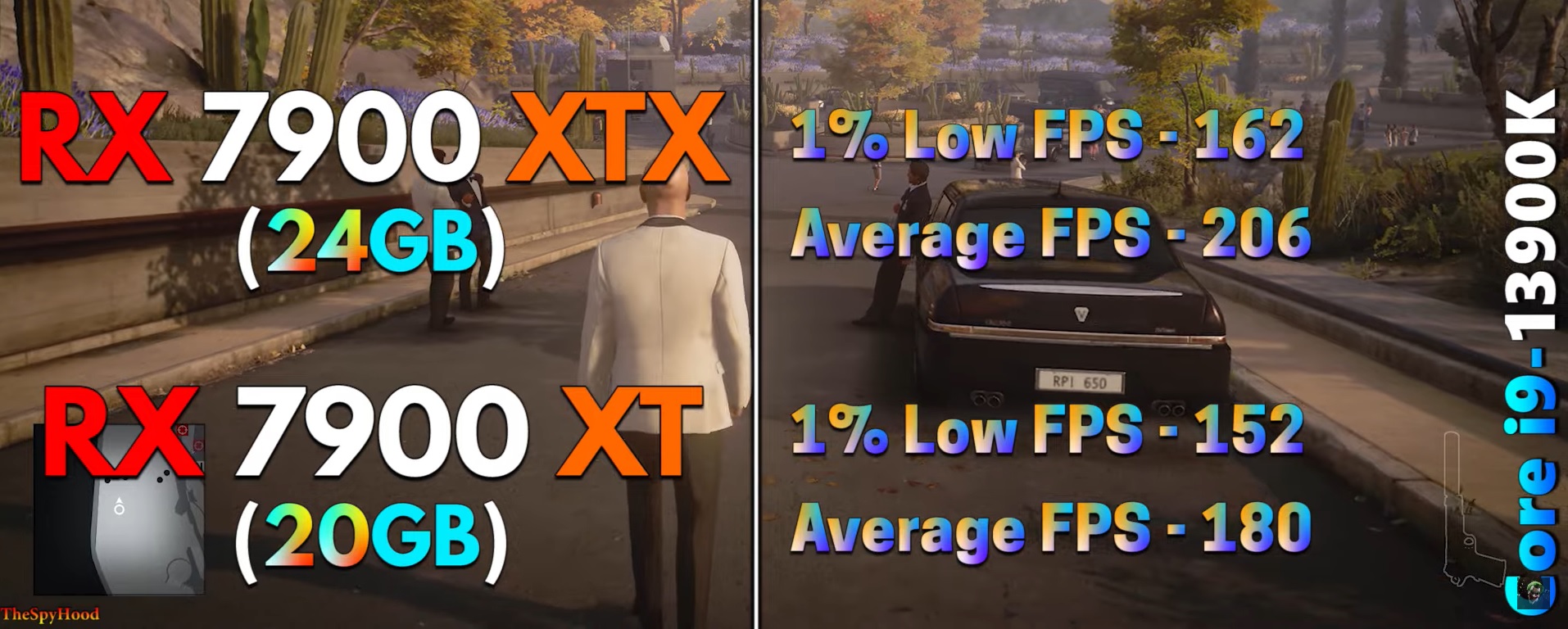
- Hitman 3 ended up in favor of 7900 XTX as it enjoyed a slightly above-average lead of 13.7%.
- It was steadily pushing out 206 fps on average. 7900 XTX could not keep up with this performance and maxed out on 180 average fps.
- The difference in 1% lows was smaller, as 7900 XTX is now only 6% faster this time.
- On average, it yielded 162 1% low fps. 10 frames behind was 7900 XT, hovering near 152 fps.
2160p
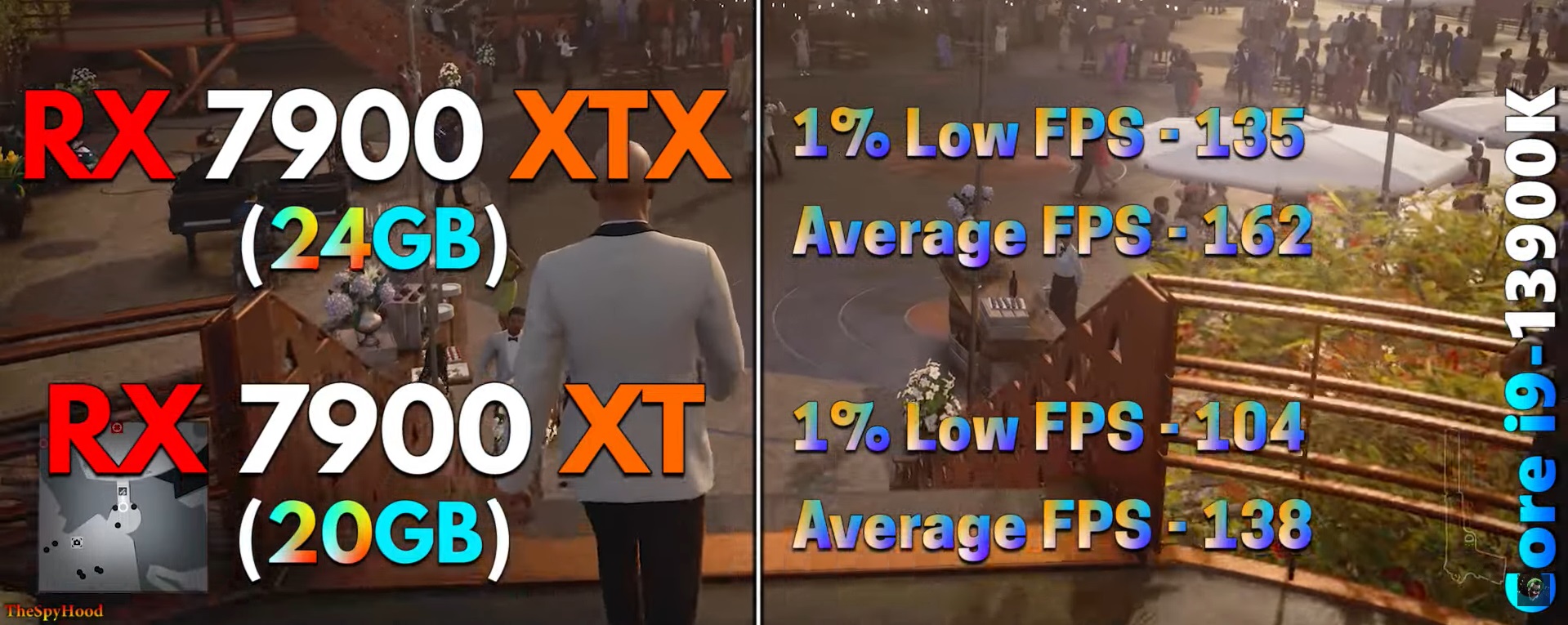
- The higher 2160p resolution was no different, as 7900 XTX was again 16% ahead, enjoying a well-deserved above-average lead.
- 7900 XTX ran the game comfortably at 162 fps compared to 138 fps by 7900 XT.
- 7900 XTX extends its lead in terms of 1% lows by a whopping margin of 26%.
- It was averaging around 135 1% low fps this time around. At the same time, the 7900 XT maxed out at 104 fps.
Red Dead Redemption 2
Red Dead Redemption is an extremely demanding title that does a very good job of being both GPU and CPU-intensive. Therefore, it makes it a perfect choice for RX 7900 XTX vs RX 7900 XT gaming comparison.
1440p
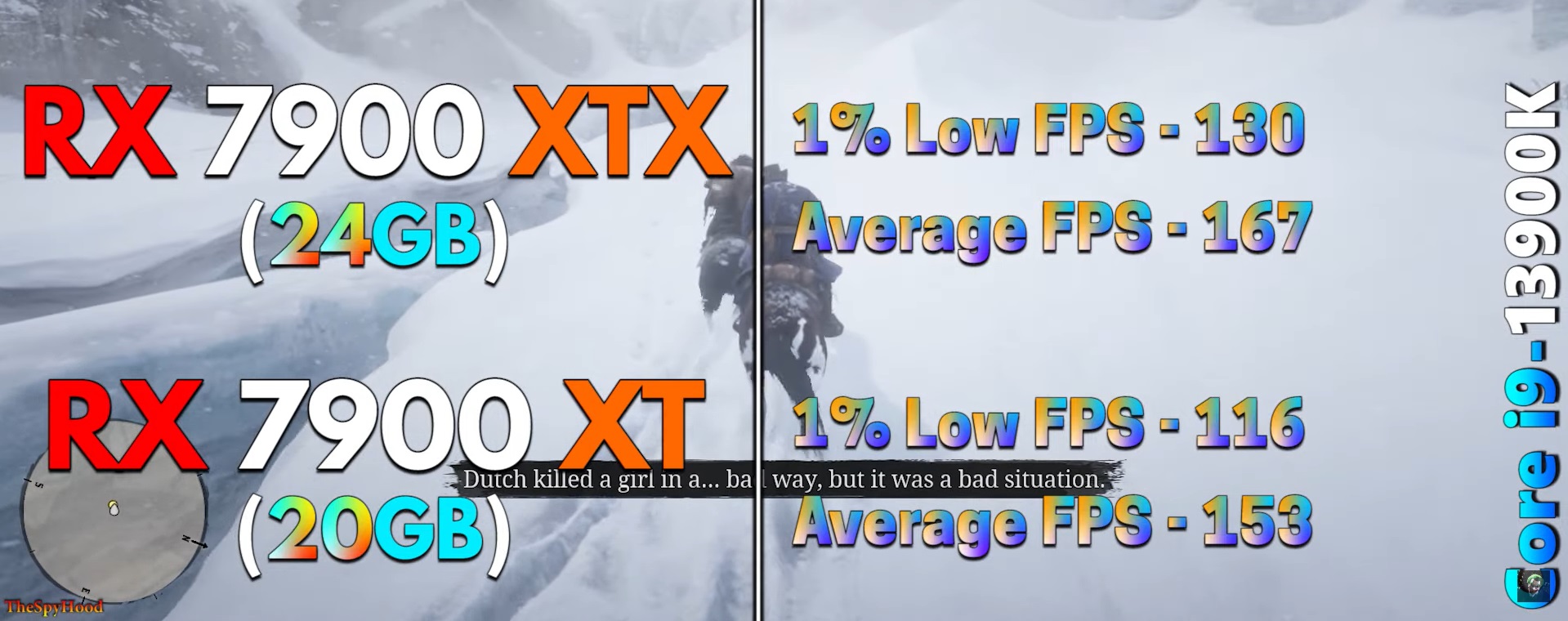
- Both of our contenders could handle Red Dead Redemption 2 fairly well, as they were running the game at over 150 fps. However, it did run slightly better on 7900 XTX, which was approximately 8.75% faster than its competitor.
- It provided a stable experience of 167 fps on average. 7900 XT was not far behind at 153 fps.
- Regarding 1% lows, 7900 XTX came on top, once again, with a bigger margin this time, of approximately 11%.
- 1% lows yielded by 7900 XTX were around 130 fps. 14 frames behind, was 7900 XT, giving us a total average of 116 1% low fps.
2160p
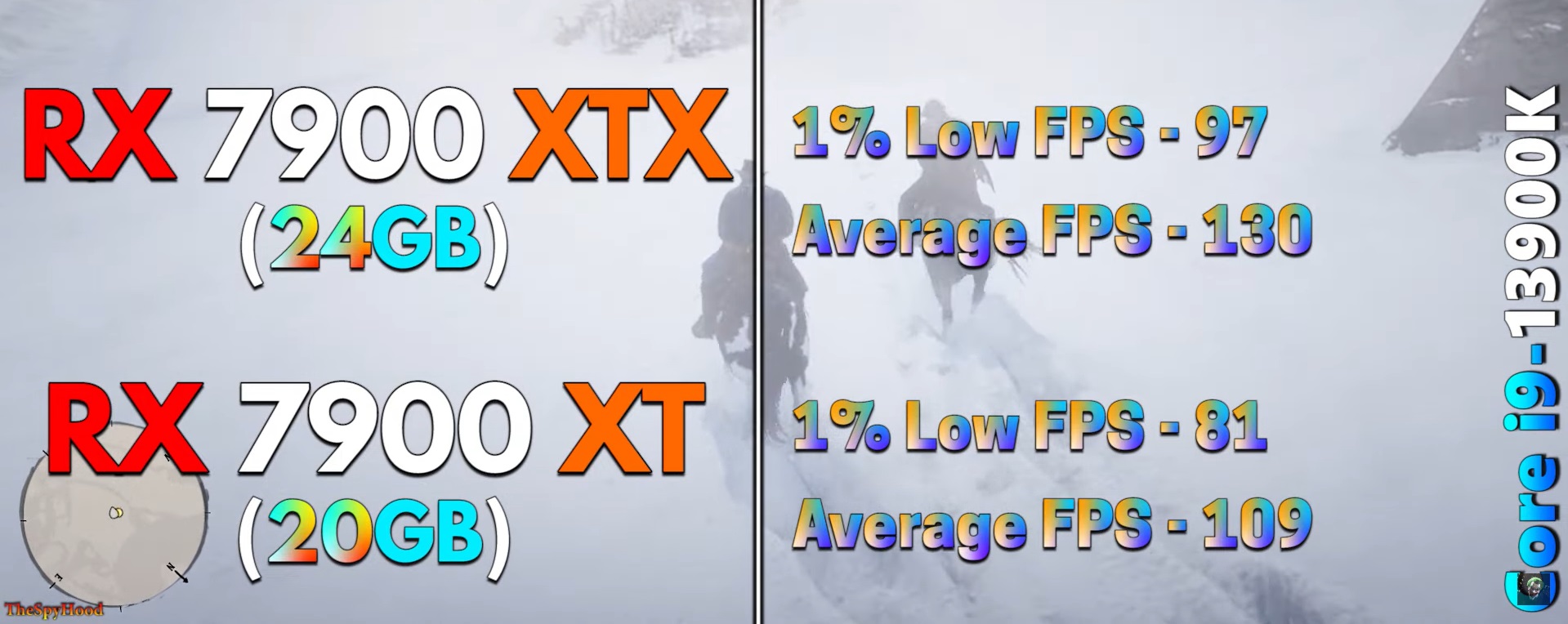
- The higher 2160p resolution elevated the difference between both GPUs, as the 7900 XTX is now 17.5% ahead of the 7900 XT.
- It provided us with a solid 130 fps experience on 4k. Contrary to that, the 7900 XT was able to offer 109 fps.
- 1% lows were not any different either, as 7900 XTX is still enjoying a respectable 18% lead.
- It was able to yield an average of 97 fps in terms of 1% lows. At the same time, 7900 XT was 16 frames behind, yielding a total of 81 1% low fps.
Call Of Duty Modern Warfare 2
Call of Duty Modern Warfare 2 is one of the very few games in this benchmark that can actually utilize both a good GPU and CPU.
1440p
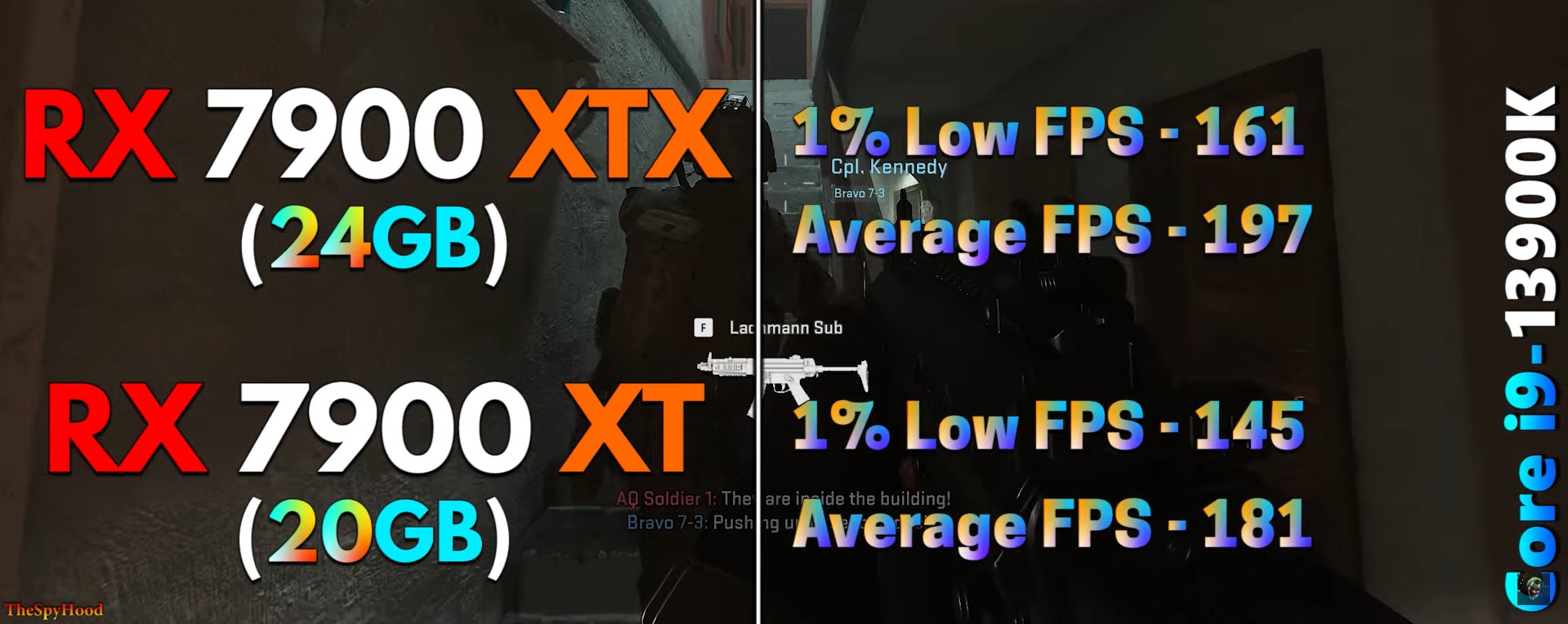
- The results from Call of Duty Modern Warfare 2 were no different either. 7900 XTX enjoys a below-average lead of 8.4% over its competitor in average fps.
- The average fps delivered by 7900 XTX lingered around 197 fps. Next to that, the 7900 XT was able to yield 181 fps on average.
- 1% lows did not seem to paint a different picture, as 7900 XTX was still 10% ahead of its competitor.
- It was still 15 fps ahead, averaging around 161 1% low fps. 7900 XT, on the other hand, could only deliver an average of 145 fps.
2160p
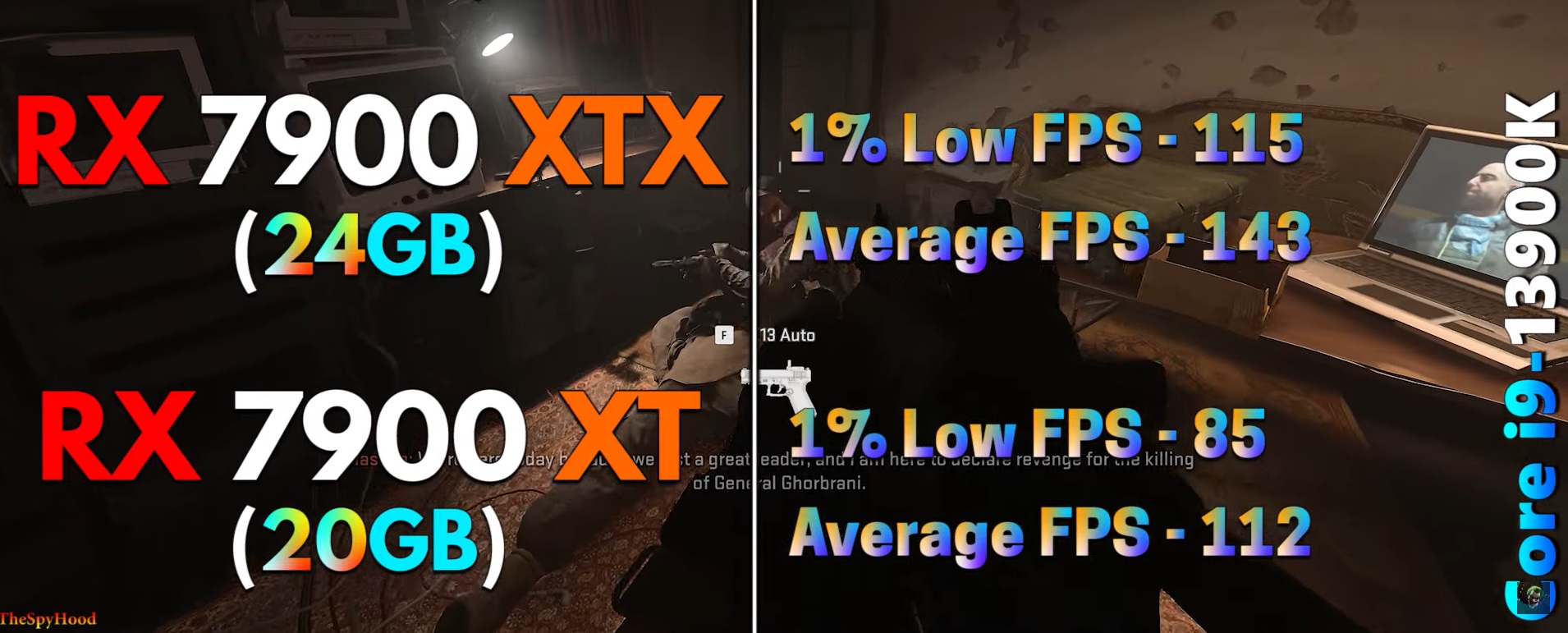
- 7900 XTX completely wiped the floor on the higher 2160p resolution, as it was 24% ahead of 7900 XT.
- It manages to give an average of a respectable 143 fps. 7900 XT had no chance of keeping up as it maxed out at 112 fps.
- The bashing continues for 7900 XT, even in the 1% lows, as it is now 30% behind its competitor. This is one of the biggest differences observed throughout this benchmark.
- 7900 XTX delivered an average of 115 fps when it came to 1% lows. Even the 1% lows of it were higher than the average frame rate of 7900 XT. In comparison to that, the 7900 XT capped out at 85 fps.
Assassin’s Creed Valhalla
Being a Ubisoft title, Assassin’s Creed Valhalla does not have the best optimization, making it a perfect title for our competitor to lock horns in.
1440p
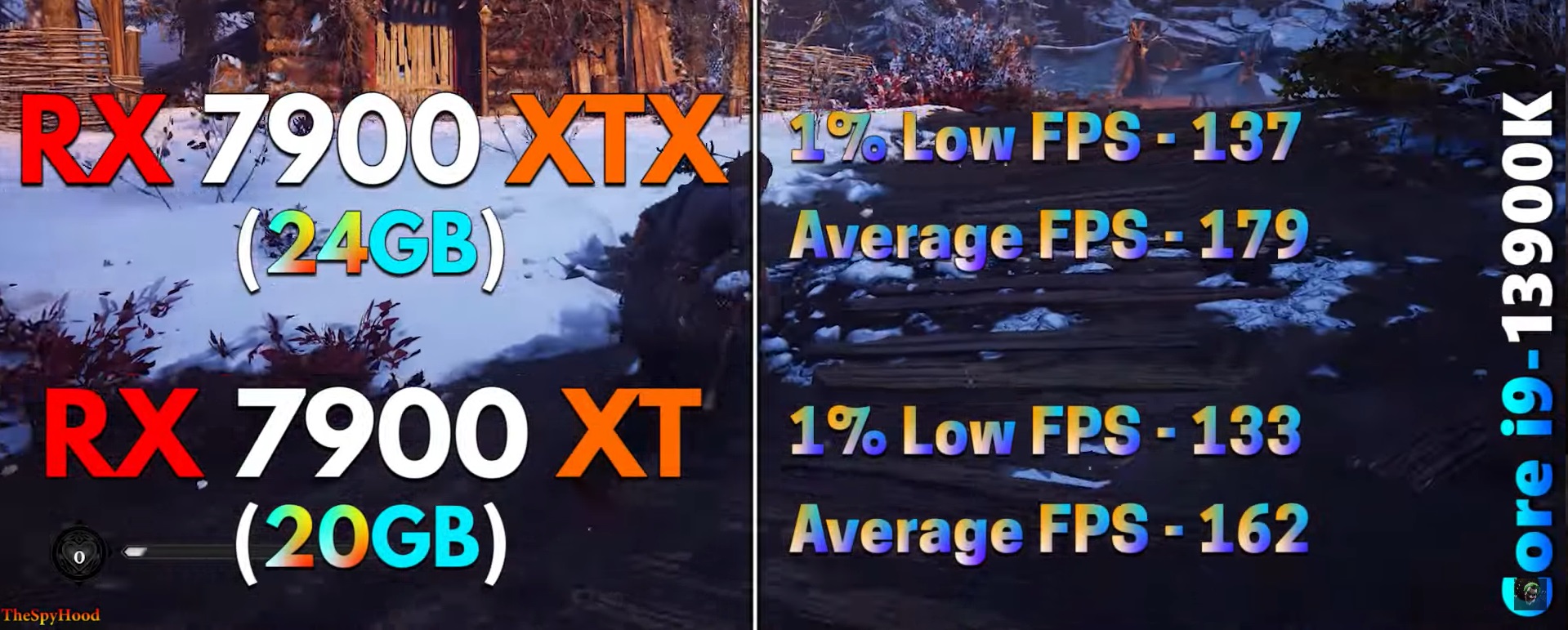
- After locking horns in Assassin’s Creed Valhalla, 7900 XTX again comes on top with a very average margin of 10%.
- It provided a solid 179 fps on average compared to 162 average fps by 7900 XT.
- To 7900 XT’s credit, it did manage to close the gap quite a bit, to a mere 2.9%.
- It pushed out 137 frames in terms of 1% lows. 7900 XT, on the other hand, was just 4 frames shy, yielding us an average of 133 1% low fps.
2160p
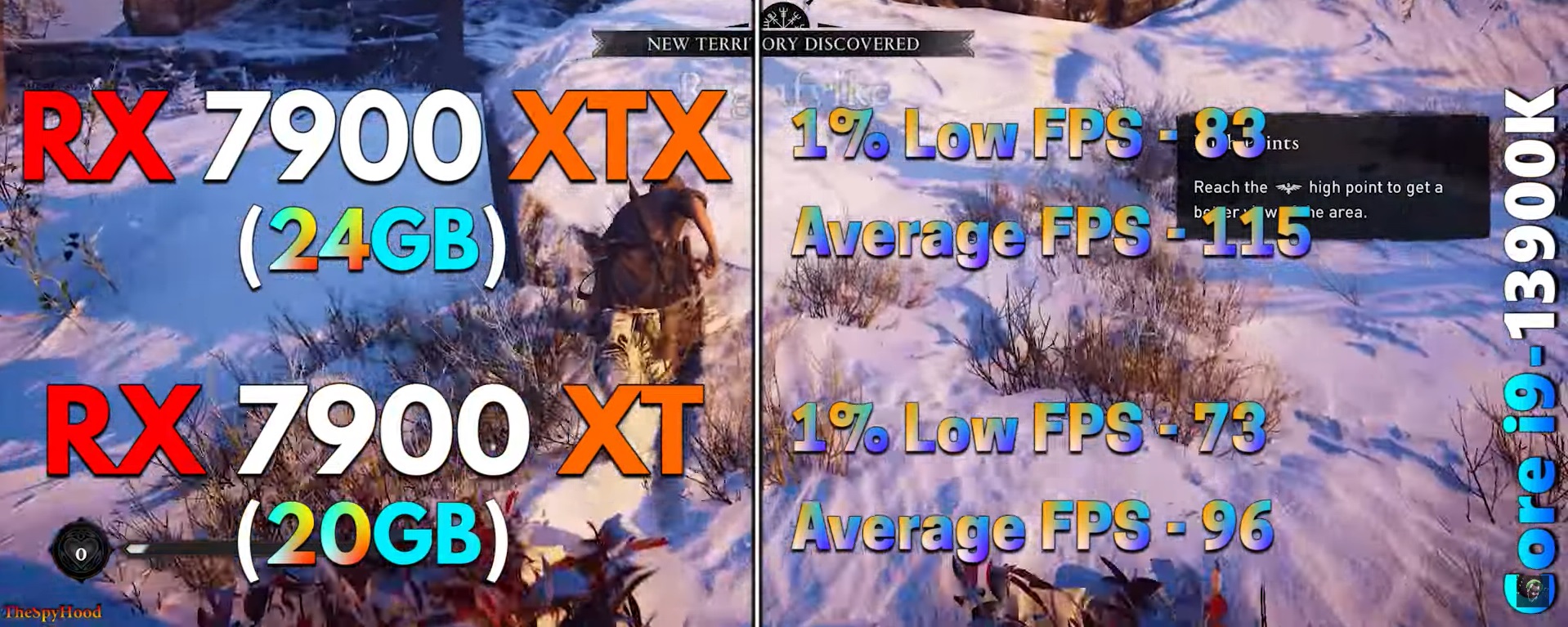
- The higher 2160p resolution was equally merciless on both GPUs, as the average fps have taken a significant hit. 7900 XTX still retains the lead by a margin of 18%.
- It delivered an average of 115 fps. 7900 XT, this time, was 19 frames behind and just shy of 4 frames from reaching triple digits, giving us an average of 96 fps.
- 1% lows saw a slightly smaller difference of 12%, with 7900 XTX coming on top.
- It yielded 83 fps in terms of 1% lows, and exactly 10 frames behind were 7900 XT, with an average of 73 fps.
Similar comparison: i9-12900K vs Ryzen 9 5900X
Dying Light 2
Dying Light 2 is a newly released title that is equally merciless on CPU and GPU. The game is generally more demanding than other games we have tested in our RX 7900 XTX vs RX 7900 XT gaming benchmarks.
1440p
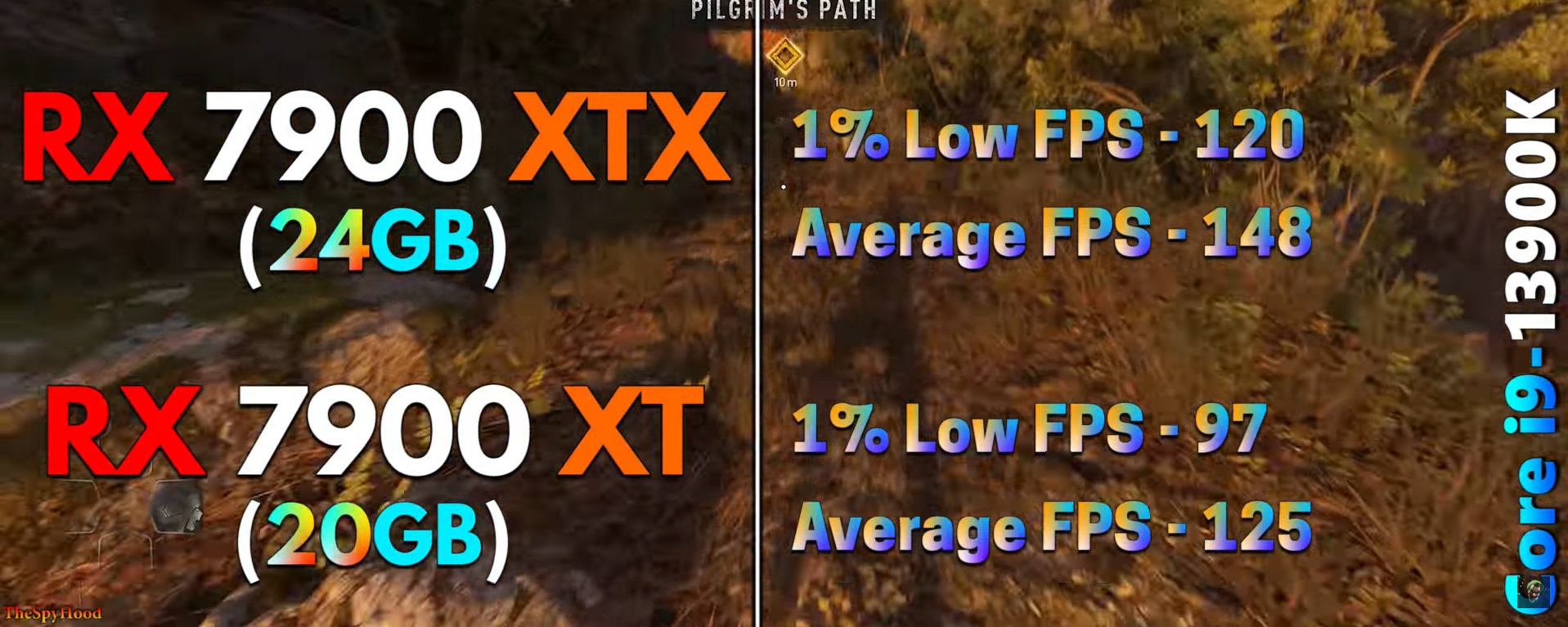
- As anticipated, Dying Light 2 prefers 7900 XTX over 7900 XT, as the game ran 17% faster.
- The 7900 XTX was able to run the game at 148 fps on average. 7900 XT was slightly behind, struggling to catch up by averaging around 125 fps.
- 1% lows saw a slightly bigger difference of around 21% in favor of 7900 XTX.
- It pushed out 120 1% low frames on average. 7900 XT, on the other hand, could only yield 97 fps.
2160p
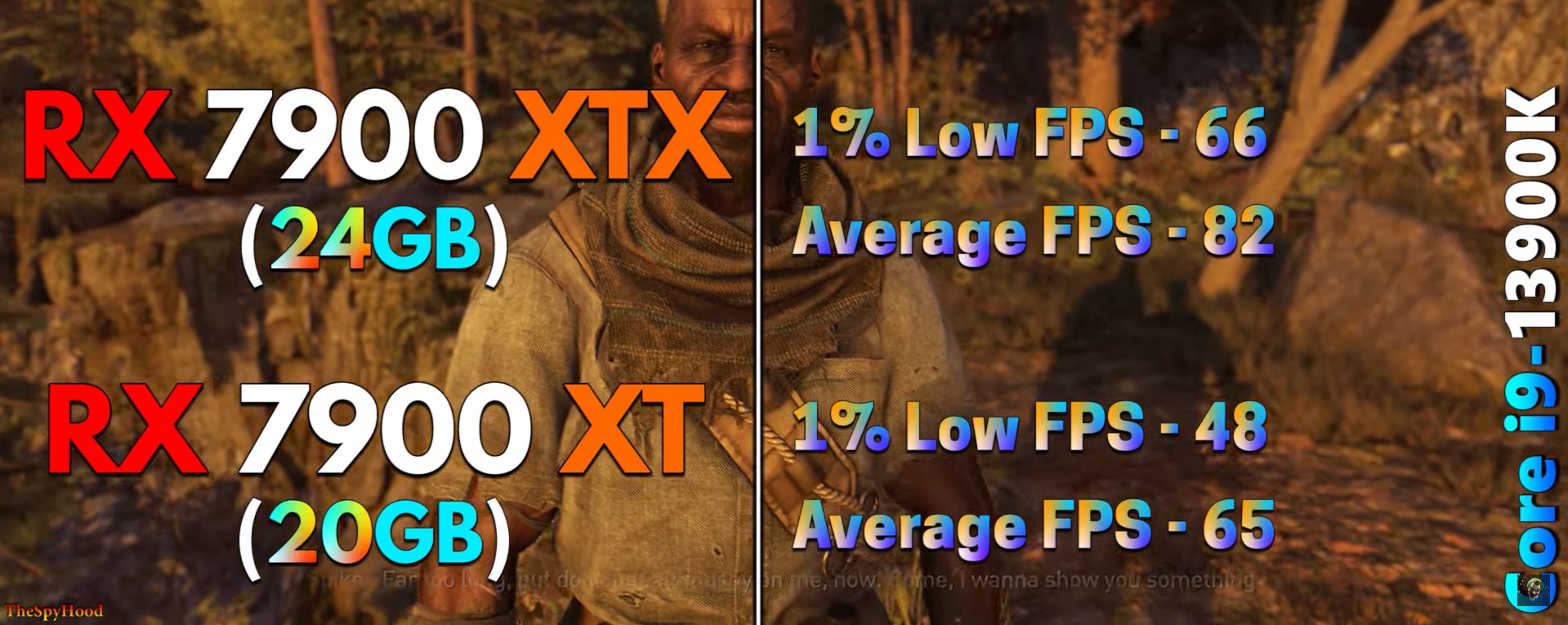
- 2160p is a little demanding, as both of our GPUs fall into double digits this time. However, 7900 XTX is able to maintain another above-average lead of around 23%.
- It delivered an average of 82 fps, which is respectable at this demanding title on this resolution. At the same time, the 7900 XTX is also providing a stable experience of 65 fps on average.
- The performance gap between both GPUs expands in terms of 1% as our former winner, 7900 XTX, is now a whopping 31.1% ahead of its competitor.
- The game ran much smoother on 7900 XTX, which yielded 66 fps in the 1% lows category. 7900 XT, next to that, maxed out at 48 fps.
Far Cry 6
Far Cry 6 has major optimization issues. It relies heavily on the CPU’s cores and threads despite being a DirectX 12 title.
1440p
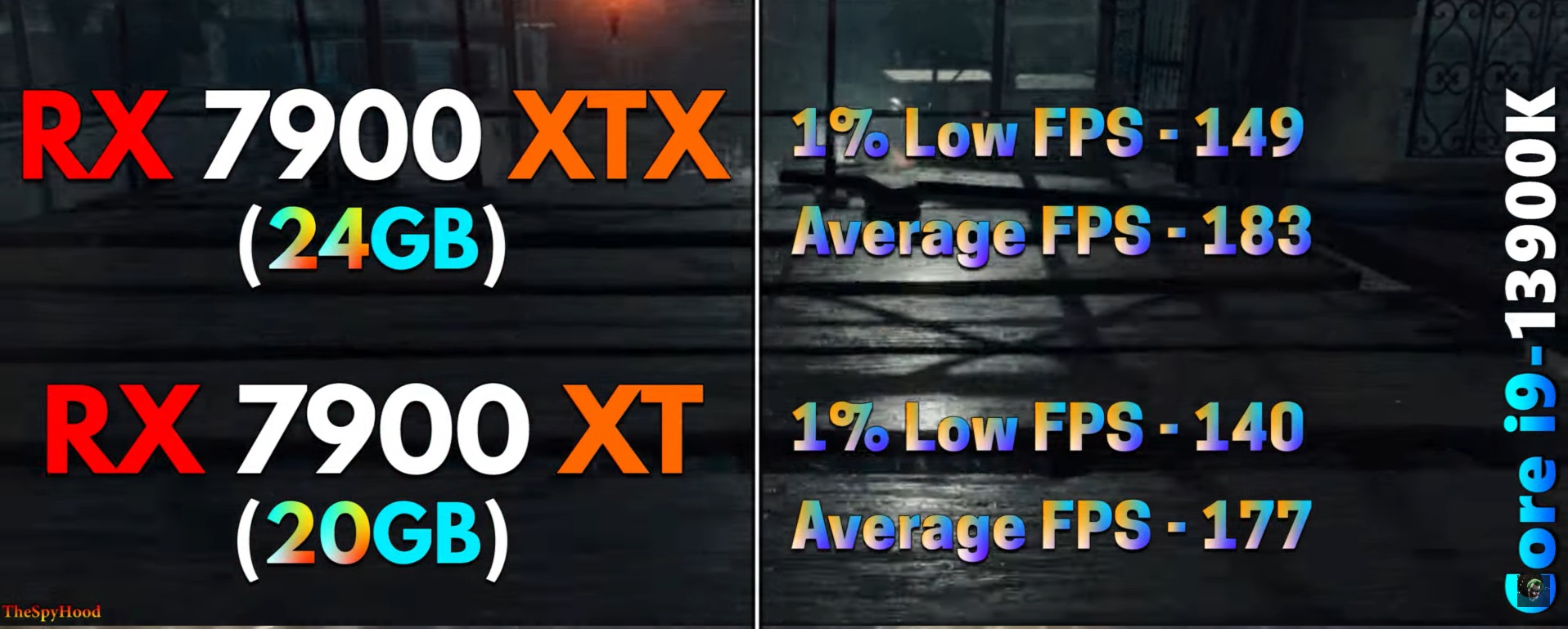
- To no one’s surprise, 7900 XTX leads our final benchmark, but this time by a mere 3% only. This is one of the smallest differences observed throughout this benchmark.
- The average fps yielded by 7900 XTX was hovering around 183. At the same time, 7900 XT was only 5 frames behind, giving us an average of 177 fps.
- Regarding 1% lows, 7900 XTX was averaging around 149 fps. Conversely, 7900 XT delivered an average of 140 fps in 1% lows.
- The difference was slightly bigger this time, with 7900 XTX coming on top with a margin of 6.2%.
2160p
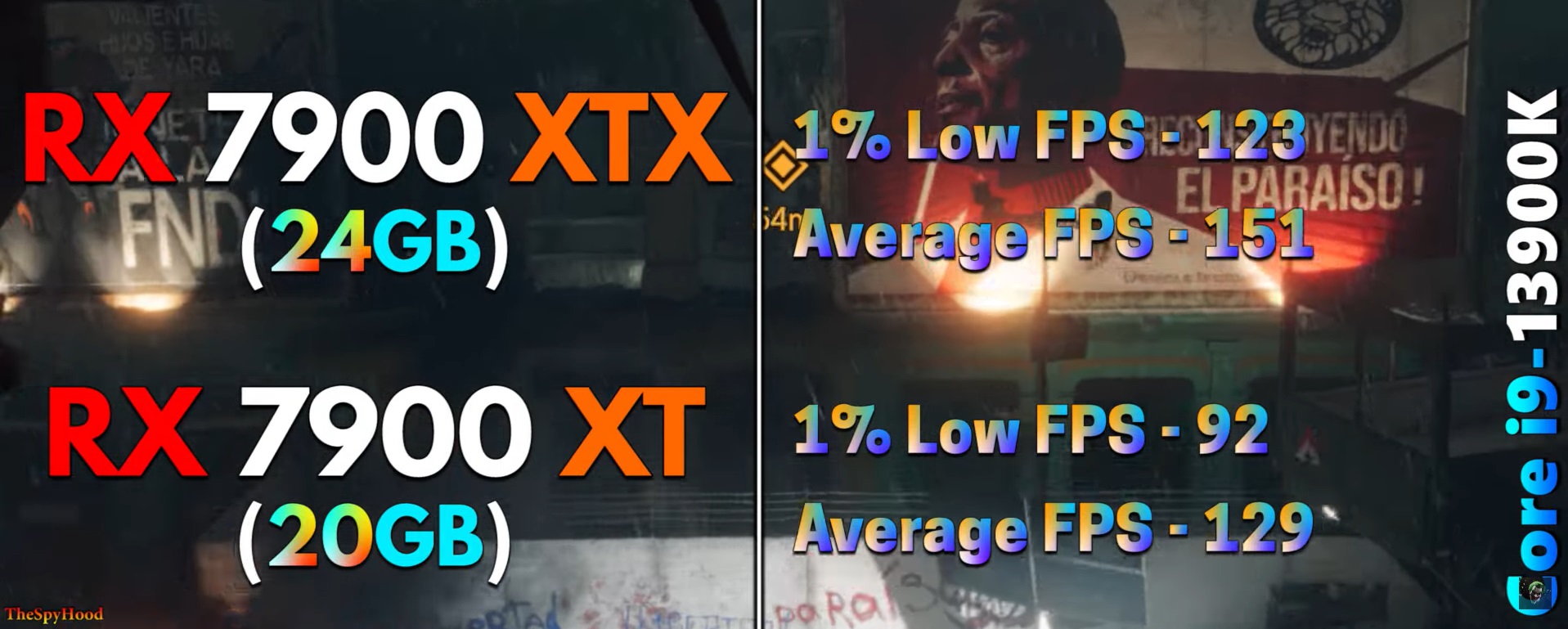
- The difference at the higher 2160p seems to have expanded to 15% in favor of 7900 XTX.
- 7900 XTX just managed to top the 150 fps mark by giving us an average of 151 fps. Contrary to that, the 7900 XT was struggling to catch up, averaging around 129 fps.
- 1% lows yielded by 7900 XTX were around 123 fps compared to 92 by 7900 XT.
- The margin in 1% lows was huge at 28%, with 7900 XTX coming on top.
Overall Gaming Performance
From the RX 7900 XTX vs RX 7900 XT gaming benchmarks we have seen so far, it is safe to say that the Radeon RX 7900 XTX is anywhere between 3 to 23% better than Radeon RX 7900 XT in games, depending on the game, resolution, and settings.
Now, for a more in-depth analysis, we will take average fps, and 1% lows from the 10 titles tested and calculate their mean. This will give us a better estimate of how much performance difference we can generally expect between these GPUs. Also, make sure to give our RX 7900 XTX vs Radeon RX 6950 XT comparison a read as well.
1440p
Even though both of these GPUs were made for 4k gaming, the difference between them in 1440p was clear. 7900 XTX wiped the floor with a clear win in every title we tested today. 7900 XT was struggling to catch up even though we were CPU bound in some games. This shows the dominance of 7900 XTX throughout the benchmark, that even at the lower resolutions where we are CPU bound, 7900 XTX will provide its users with an edge.
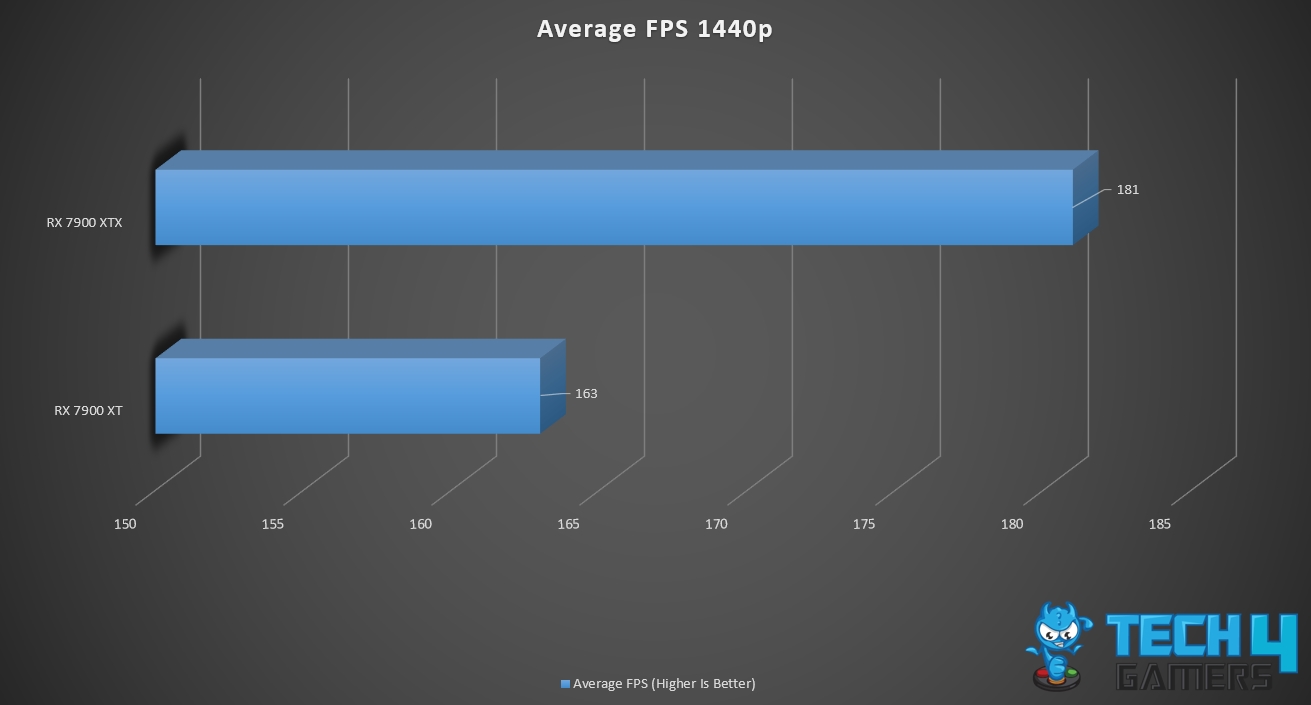
The biggest difference in average fps on 1440p resolution between these two GPUs was observed in Dying Light 2, where 7900 XTX was 17% better. At the same time, the smallest difference was observed in Far Cry 6, where 7900 XT was only 3% behind.
2160p
As we move over to the higher resolutions, the load from the CPU gets taken off, and the GPU has to pay the price as games depend more on the GPU to render those frames at a higher resolution. The higher resolutions depict the performance differences more clearly between the two GPUs.
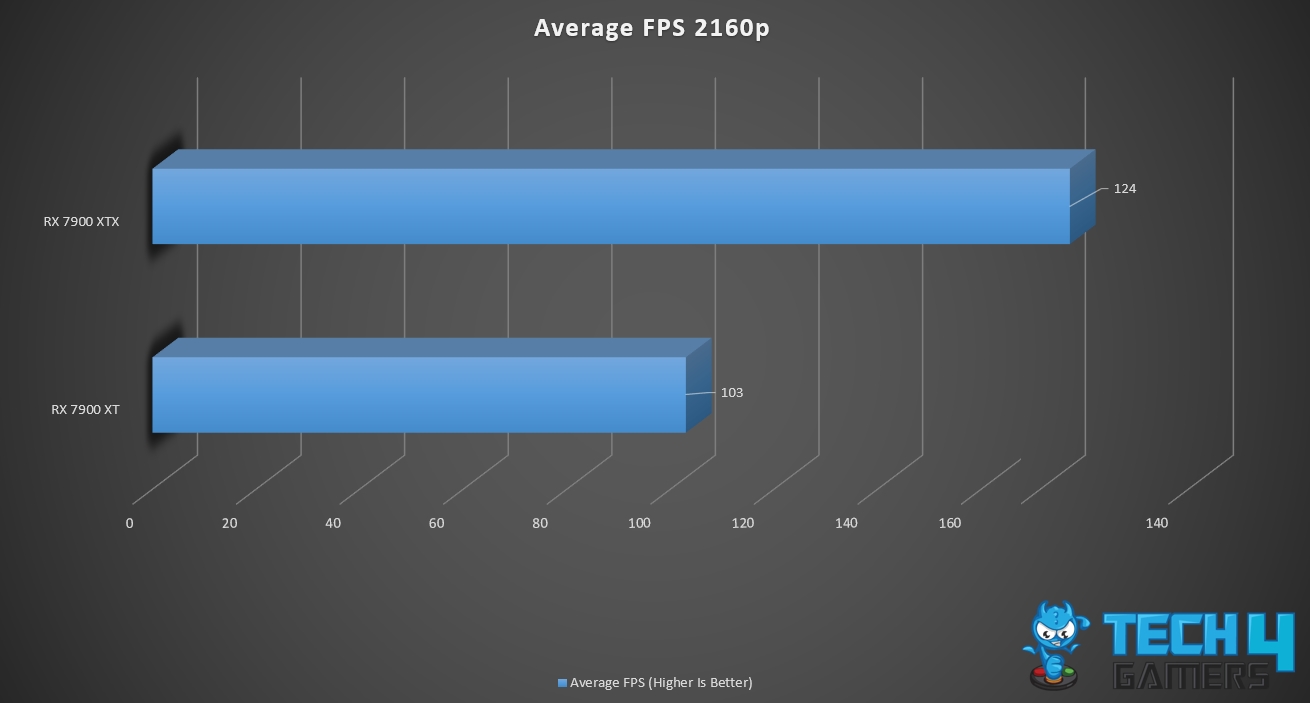
Compared to that, the 7900 XT gave us an average of 103 fps. The difference was bigger in 1% lows, where 7900 XTX was now 24.25% faster than 7900 XT. A mean of 1% lows yielded by 7900 XTX in 10 different games, on 2160p resolution was 98 fps. At the same time, the 7900 XT was able to push out an average of 76.8 fps.
The biggest difference in average fps on 2160p resolution between these two GPUs was observed in Call of Duty Modern Warfare 2, where 7900 XTX was 24% better. The smallest difference was observed in Call of Duty Warzone 2, where 7900 XT was only 8% behind.
Power Consumption And Thermal Efficiency
Let’s take a look at the power consumption and thermal efficiency of RX 7900 XTX vs RX 7900 XT.
Total Power Draw
Power consumption is an important aspect to consider when buying a new GPU, especially if you are limited on budget and have a smaller PSU. In terms of power efficiency, we have to give it to RX 7900 XT for being more power efficient. It has approximately 16.8% lower TDP. RX 7900 XTX has a TDP of 355 watts. Exactly 55 watts lower is the TDP of RX 7900 XT at 300 watts. Since it has a smaller TDP, it’s suggested PSU is also 6% smaller. The suggested PSU for RX 7900 XT is 700 watts, and if you decide to go with RX 7900 XTX, you’ll have to spec your PSU up to 750 watts.
Now, in order to get a more realistic idea of the power consumption of both these GPUs, we will be calculating an average of total power drawn by our system during our gaming benchmarks so you can expect what type of PSU you need to pair with these GPUs. Keep in mind that both GPUs were running at the stock configuration, so if you are planning to overclock, you will have to get a bigger PSU.
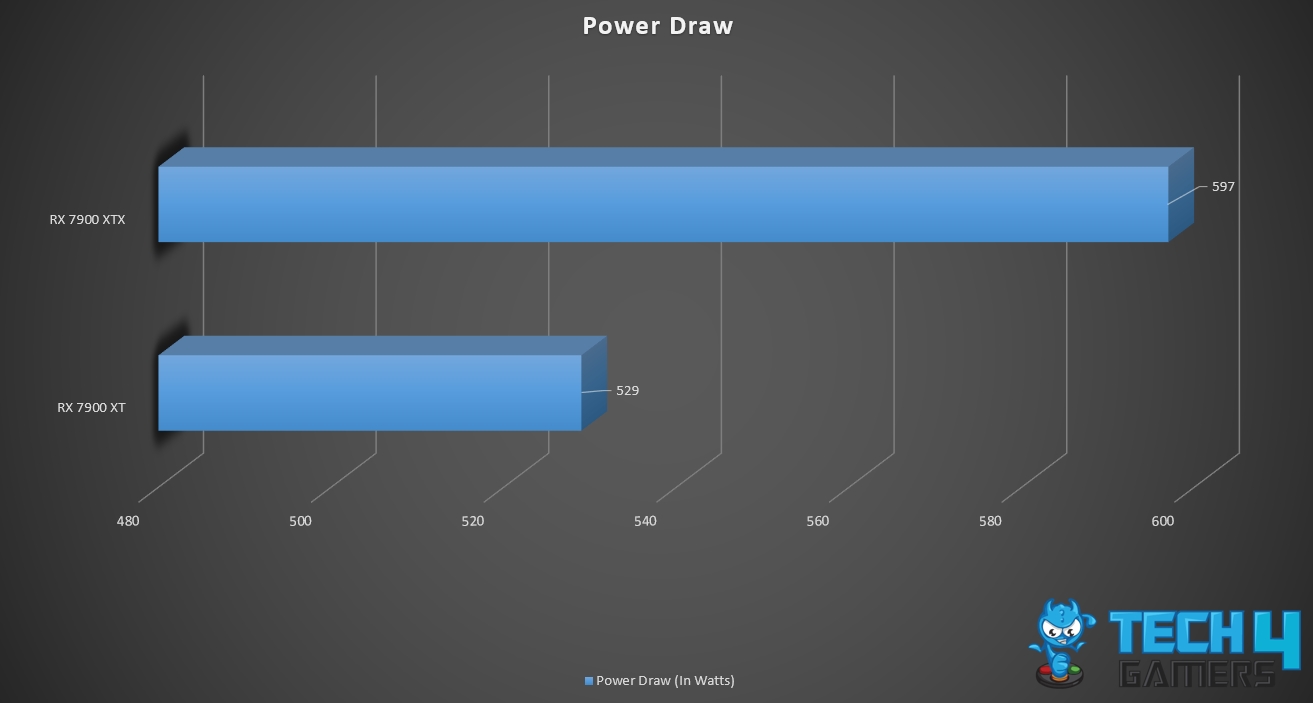
Thermal Efficiency
Thermals are another aspect to consider when buying a new GPU, especially if you live in a place with a warmer climate. The thermal efficiency of both these GPUs will depend greatly on the variant you buy and the type of fans it comes with. But for a rough estimate, we will calculate the average of the temperatures these GPUs were running on during our benchmark and the mean out of it.
However, we do recommend taking this information with a grain of salt. As previously mentioned, every variant comes with a different set of fans, and the thermal efficiency will also depend on it.
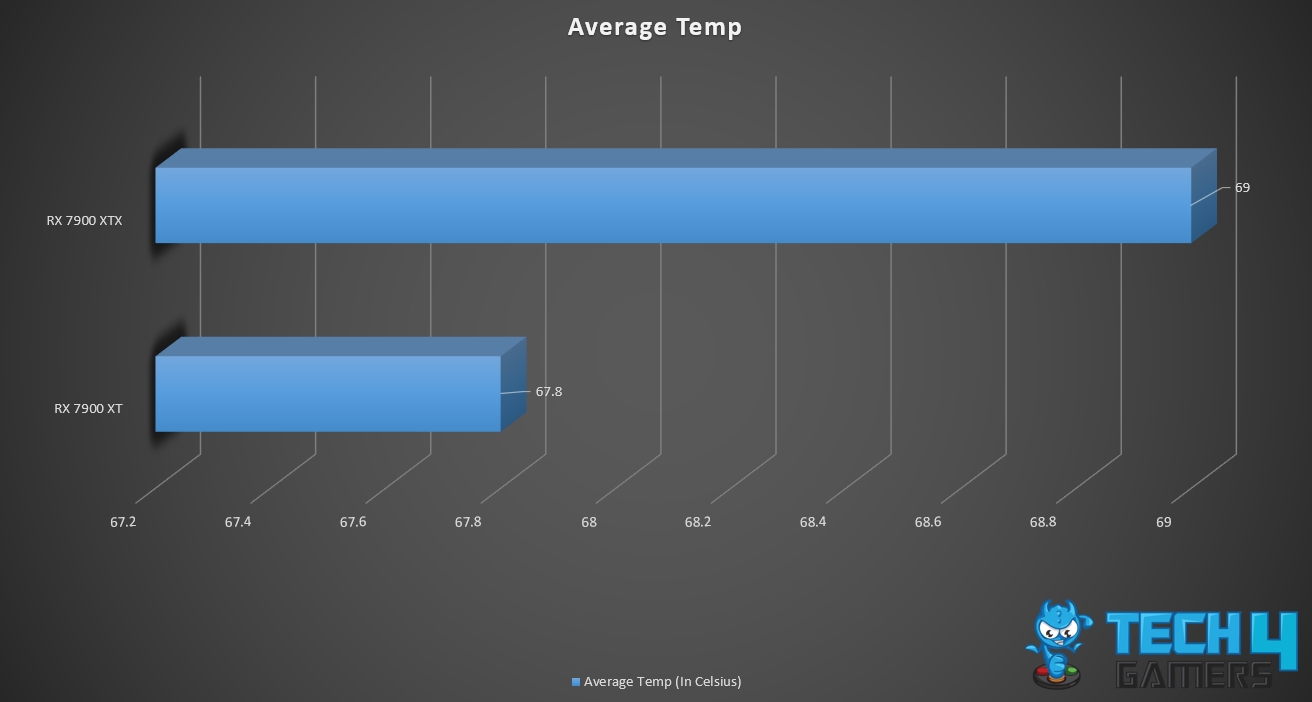
This does mean that 7900 XTX was a little more thermally efficient by a smaller margin of 1.75%. However, in a more realistic scenario, this will not make a day and night difference as neither of these GPUs was near their thermal throttling limit.
If your GPU does end up thermal throttling, you might want to check out our guide on how to lower GPU temperature.
Pricing And Availability
The most important aspect to consider when you are limited on a budget but also looking for a GPU that can fulfill your needs is pricing. Lucky for us, AMD has released both of these GPUs for an extremely competitive price compared to the performance these GPUs bring to the table.
If we compare the MSRP of RX 7900 XTX vs RX 7900 XT, we can say that the 7900 XT is the better bang for the buck. It was released for a competitive price of 9 USD, which left shocks in the gaming community, especially after seeing its performance.
7900 XTX, on the other hand, was launched for 999 USD, and it received a lot of praise from the gamers community. Despite the fact that it was 10% more expensive than the 7900 XT, this GPU is loved globally because AMD launched it to compete with the biggest offerings from their rival Nvidia. The 10% extra cost also seems like a fair trade if we look at the performance gains this GPU offers over 7900 XT.
In the end, both of these GPUs are a very good deal if you find them at their given MSRP. If you are on a tight budget for a GPU, the 7900 XT is a better deal. It costs less money while also delivering top-notch performance. However, if you can afford to spend a hundred extra bucks, it is recommended to go for the 7900 XTX as it provides a substantial gain in performance as compared to the 7900 XT.
Which One Should You Get?
AMD Radeon RX 7900 XTX and Radeon RX 7900 XT are two of the best modern-day GPUs you can find in the market these days. They both fall into the $900-1000 category and offer fantastic performance for the price they are being sold at. They also require a similar 750 watts PSU. However, which one you should get will depend greatly on your usage and requirement.
If we look at it purely from a performance standpoint, then 7900 XTX will easily wipe the floor. It won every single one of our gaming benchmarks by respectable margins. It can provide anywhere between 3 to 23% more frames in games, depending on the game, resolution, and settings. It also has superior architecture and offers better rendering configuration, so if you are a content creator, then your work will greatly benefit from it.
However, if you are on a tight budget but also need a GPU that can run games at 4k and you are not into content creation, then 7900 XT is also a really good deal for you. It provides excellent performance for the price it is being sold at. You can use it on a smaller PSU. It directly competes with the higher-tier GPUs from Nvidia while also costing substantially less. Sure, you will be missing some of the bells and whistles, but even after that, it will be a really good deal. In any case, we hope that you enjoyed reading our RX 7900 XTX vs RX 7900 XT comparison. Before leaving, do make sure to read our RX 7900 XT vs RTX 3080 comparison.
Frequently Asked Questions
AMD RX 7900 XTX performs 3 to 23% better in games than AMD RX 7900 XT.
RX 7900 XT is the more power efficient of the two as it has a smaller TDP and PSU requirement.
7900 XT is the better bang for the buck since it costs 10% less while also delivering top-tier performance.
Also Read:
Thank you! Please share your positive feedback. 🔋
How could we improve this post? Please Help us. 😔
[Comparisons Specialist]
I’m a passionate computer hardware expert specializing in CPUs and GPUs. With a lifelong curiosity for hardware and extensive hands-on experience, I provide valuable insights, practical advice, and in-depth analysis on these components. Engaging with the hardware community, I exchange knowledge and stay at the forefront of technological advancements.
Get In Touch: [email protected]



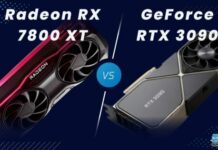
![Core i5-13600k Vs i5-12600K [We Tested 7 Games] Intel Core i5 13600k vs Intel Core i5 12600k](https://tech4gamers.com/wp-content/uploads/2022/11/Intel-Core-i5-13600k-vs-Intel-Core-i5-12600k-218x150.jpg)
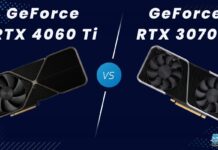
![Core i5-13400 Vs Ryzen 5 7600 [We Tested 9 Games] Core i5-13400 Vs Ryzen 5 7600](https://tech4gamers.com/wp-content/uploads/2023/04/Comparison-1-218x150.jpg)
![RTX 4070 Ti Vs RTX 3080 Ti [Gaming Benchmarks + Overall]](https://tech4gamers.com/wp-content/uploads/2023/01/RTX-4070-TI-VS-3TX-3080-TI-218x150.jpg)
